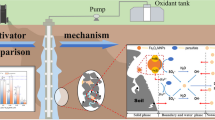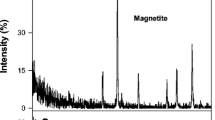Abstract
The present work studies the remediation of a B20 (20 % biodiesel, 80 % diesel) biodiesel blend-contaminated soil (1,000 mg kg−1) with persulfate activated by iron. Three different sources of iron (Fe(II)), granular zerovalent iron (gZVI), and a slurry of nanoparticles of zerovalent iron (nZVI), without pH adjustment were tested. Besides, the effect of the addition of chelating agents, such as trisodium citrate (SC), or citric acid (CiA), has been also studied. SC promotes pH under near-neutral conditions and reaction takes place at low rate at these experimental conditions. On the other hand, the use of CiA leads to an acidic pH and chelating agent is oxidized at higher rate than total petroleum hydrocarbons (TPH). Therefore, CiA addition does not seem to produce any improvement on the removal efficiency of TPH. Regarding the three different sources of iron used as activators, Fe(II), gZVI and nZVI, in absence of chelating agent, under acidic pH and by adding the same amount of iron, the highest TPH conversion was obtained with ZVI (about 60 %), while a conversion of about 40 % was obtained with the addition of Fe(II). The maximum TPH conversion value was achieved in shorter time using nZVI. Concerning the removal efficiency of each fraction of biodiesel abated, fatty acid methyl esters (FAME) were by far the easiest to oxidize, achieving 100 % of conversion, either by using Fe(II) or nZVI activated persulfate.







Similar content being viewed by others
References
Al-Shamsi, M. A., & Thomson, N. R. (2013). Treatment of a trichloroethylene source zone using persulfate activated by an emplaced nano-Pd-Fe-0 zone. Water Air and Soil Pollution, 224(11), doi: 10.1007/s11270-013-1780-1.
Anipsitakis, G. P., & Dionysiou, D. D. (2004). Radical generation by the interaction of transition metals with common oxidants. Environmental Science & Technology, 38(13), 3705–3712. doi:10.1021/es035121o.
Anotai, J., Bunmahotama, W., & Lu, M. C. (2011). Oxidation of aniline with sulfate radicals in the presence of citric acid. Environmental Engineering Science, 28(3), 207–215. doi:10.1089/ees.2010.0169.
Baciocchi, R. (2013). Principles, developments and design criteria of in situ chemical oxidation. Water Air and Soil Pollution, 224(12), doi: 10.1007/s11270-013-1717-8.
Bertolla, L., Porsani, J. L., Soldovieri, F., & Catapano, I. (2014). GPR-4D monitoring a controlled LNAPL spill in a masonry tank at USP, Brazil. Journal of Applied Geophysics, 103, 237–244. doi:10.1016/j.jappgeo.2014.02.006.
Bumbac, C., & Diacu, E. (2012). Coupled chemical and biological treatment of oil contaminated soils. Revista de Chimie, 63(11), 1167–1171.
Chang, Y. Y., Roh, H., & Yang, J. K. (2013). Improving the clean-up efficiency of field soil contaminated with diesel oil by the application of stabilizers. Environmental Technology, 34(11), 1481–1487. doi:10.1080/09593330.2012.758658.
Chen, Y., Li, C., Zhou, Z. X., Wen, J. P., You, X. Y., Mao, Y. Z., et al. (2014). Enhanced biodegradation of alkane hydrocarbons and crude oil by mixed strains and bacterial community analysis. Applied Biochemistry and Biotechnology, 172(7), 3433–3447. doi:10.1007/s12010-014-0777-6.
Deng, J., Shao, Y., Gao, N., Deng, Y., Tan, C., & Zhou, S. (2014). Zero-valent iron/persulfate(Fe-0/PS) oxidation acetaminophen in water. International Journal of Environmental Science and Technology, 11(4), 881–890. doi:10.1007/s13762-013-0284-2.
Do, S. H., Kwon, Y. J., & Kong, S. H. (2010). Effect of metal oxides on the reactivity of persulfate/Fe(II) in the remediation of diesel-contaminated soil and sand. Journal of Hazardous Materials, 182(1–3), 933–936. doi:10.1016/j.jhazmat.2010.06.068.
Furman, O. S., Teel, A. L., & Watts, R. J. (2010). Mechanism of base activation of persulfate. Environmental Science & Technology, 44(16), 6423–6428. doi:10.1021/es1013714.
Gallego, J. L. R., Loredo, J., Llamas, J. F., Vazquez, F., & Sanchez, J. (2001). Bioremediation of diesel-contaminated soils: evaluation of potential in situ techniques by study of bacterial degradation. Biodegradation, 12(5), 325–335. doi:10.1023/a:1014397732435.
Gu, X. G., Lu, S. G., Li, L., Qiu, Z. F., Sui, Q., Lin, K. F., et al. (2011). Oxidation of 1,1,1-trichloroethane stimulated by thermally activated persulfate. Industrial & Engineering Chemistry Research, 50(19), 11029–11036. doi:10.1021/le201059x.
Ji, Y., Ferronato, C., Salvador, A., Yang, X., & Chovelon, J.-M. (2014). Degradation of ciprofloxacin and sulfamethoxazole by ferrous-activated persulfate: implications for remediation of groundwater contaminated by antibiotics. Science of the Total Environment, 472, 800–808. doi:10.1016/j.scitotenv.2013.11.008.
Killian, P. F., Bruell, C. J., Liang, C. J., & Marley, M. C. (2007). Iron (II) activated persulfate oxidation of MGP contaminated soil. Soil and Sediment Contamination, 16(6), 523–537. doi:10.1080/15320380701623206.
Liang, C. J., & Guo, Y. Y. (2010). Mass transfer and chemical oxidation of naphthalene particles with zerovalent iron activated persulfate. Environmental Science & Technology, 44(21), 8203–8208. doi:10.1021/es903411a.
Liang, C. J., & Guo, Y. Y. (2012). Remediation of diesel-contaminated soils using persulfate under alkaline condition. Water, Air, and Soil Pollution, 223(7), 4605–4614. doi:10.1007/s11270-012-1221-6.
Liang, C. J., & Lai, M. C. (2008). Trichloroethylene degradation by zero valent iron activated persulfate oxidation. Environmental Engineering Science, 25(7), 1071–1077. doi:10.1089/ees.2007.0174.
Liang, C. J., Bruell, C. J., Marley, M. C., & Sperry, K. L. (2004a). Persulfate oxidation for in situ remediation of TCE. I. Activated by ferrous ion with and without a persulfate-thiosulfate redox couple. Chemosphere, 55(9), 1213–1223. doi:10.1016/j.chemosphere.2004.01.029.
Liang, C. J., Bruell, C. J., Marley, M. C., & Sperry, K. L. (2004b). Persulfate oxidation for in situ remediation of TCE. II. Activated by chelated ferrous ion. Chemosphere, 55(9), 1225–1233. doi:10.1016/j.chemosphere.2004.01.030.
Liang, C. J., Huang, C. F., Mohanty, N., Lu, C. J., & Kurakalva, R. M. (2007). Hydroxypropyl-beta-cyclodextrin-mediated iron-activated persulfate oxidation of trichloroethylene and tetrachloroethylene. Industrial & Engineering Chemistry Research, 46(20), 6466–6479. doi:10.1021/ie0705148.
Liang, C. J., Liang, C. P., & Chen, C. C. (2009). pH dependence of persulfate activation by EDTA/Fe(III) for degradation of trichloroethylene. Journal of Contaminant Hydrology, 106(3–4), 173–182. doi:10.1016/j.jconhyd.2009.02.008.
Lo, I. M. C., Tanboonchuy, V., Yan, D. Y. S., Grisdanurak, N., & Liao, C. H. (2012). A hybrid approach for PAHs and metals removal from field-contaminated sediment using activated persulfate oxidation coupled with chemical-enhanced washing. Water, Air, and Soil Pollution, 223(8), 4801–4811. doi:10.1007/s11270-012-1236-z.
Luo, Q. S. (2014). Oxidative treatment of aqueous monochlorobenzene with thermally-activated persulfate. Frontiers of Environmental Science & Engineering, 8(2), 188–194. doi:10.1007/s11783-013-0544-x.
Marchal, R., Penet, S., Solano-Serena, F., & Vandecasteele, J. P. (2003). Gasoline and diesel oil biodegradation. Oil & Gas Science and Technology-Revue D Ifp Energies Nouvelles, 58(4), 441–448. doi:10.2516/ogst:2003027.
Martí, F. B. (2002). Química analítica cualitativa. Madrid: Paraninfo.
Mitre, T. K., Leao, M. M. D., & Alvarenga, M. C. N. (2013). Treatment of water contaminated by diesel/biodiesel using fenton process. Engenharia Sanitaria E Ambientale, 17(2), 129–136.
Oh, S. Y., & Shin, D. S. (2014). Treatment of diesel-contaminated soil by fenton and persulfate oxidation with zero-valent iron. Soil and Sediment Contamination, 23(2), 180–193. doi:10.1080/15320383.2014.808170.
Oh, S. Y., Kim, H. W., Park, J. M., Park, H. S., & Yoon, C. (2009). Oxidation of polyvinyl alcohol by persulfate activated with heat, Fe2+, and zero-valent iron. Journal of Hazardous Materials, 168(1), 346–351. doi:10.1016/j.jhazmat.2009.02.065.
Pardo, F., Rosas, J., Santos, A., & Romero, A. (2014a). Remediation of a biodiesel blend-contaminated soil by using a modified fenton process. Environmental Science and Pollution Research, 21(21), 12198–12207. doi:10.1007/s11356-014-2997-2.
Pardo, F., Rosas, J. M., Santos, A., & Romero, A. (2014b). Remediation of soil contaminated by NAPLs using modified fenton reagent: application to gasoline type compounds. Journal of Chemical Technology and Biotechnology. doi:10.1002/jctb.4373.
Pereira, C. A., Marques, M. R. D., & Perez, D. V. (2009). Evaluation of potencial fenton-like process to the remediation of contaminated soils by diesel. Quimica Nova, 32(8), 2200–2202.
Rodriguez, S., Vasquez, L., Costa, D., Romero, A., & Santos, A. (2014). Oxidation of Orange G by persulfate activated by Fe(II), Fe(III) and zero valent iron (ZVI). Chemosphere, 101, 86–92. doi:10.1016/j.chemosphere.2013.12.037.
Romero, A., Santos, A., Vicente, F., & Gonzalez, C. (2010). Diuron abatement using activated persulphate: effect of pH, Fe(II) and oxidant dosage. Chemical Engineering Journal, 162(1), 257–265. doi:10.1016/j.cej.2010.05.044.
Siegrist, R. L., Crimi, M., & Simpkin, T. J. (2011). In situ chemical oxidation for groundwater remediation. New York: Springer.
Soliman, R. M., El-Gendy, N. S., Deriase, S. F., Farahat, L. A., & Mohamed, A. S. (2014). The evaluation of different bioremediation processes for Egyptian oily sludge polluted soil on a microcosm level. Energy Sources Part A Recovery Utilization and Environmental Effects, 36(3), 231–241. doi:10.1080/15567036.2012.711799.
Sutton, N. B., Grotenhuis, T., & Rijnaarts, H. H. M. (2014). Impact of organic carbon and nutrients mobilized during chemical oxidation on subsequent bioremediation of a diesel-contaminated soil. Chemosphere, 97, 64–70. doi:10.1016/j.chemosphere.2013.11.005.
Tan, C. Q., Gao, N. Y., Deng, Y., An, N., & Deng, J. (2012). Heat-activated persulfate oxidation of diuron in water. Chemical Engineering Journal, 203, 294–300. doi:10.1016/j.cej.2012.07.005.
Tang, J. C., Lu, X. Q., Sun, Q., & Zhu, W. Y. (2012). Aging effect of petroleum hydrocarbons in soil under different attenuation conditions. Agriculture, Ecosystems & Environment, 149, 109–117. doi:10.1016/j.agee.2011.12.020.
Triszcz, J. M., Port, A., & Einschlag, F. S. G. (2009). Effect of operating conditions on iron corrosion rates in zero-valent iron systems for arsenic removal. Chemical Engineering Journal, 150(2–3), 431–439. doi:10.1016/j.cej.2009.01.029.
Tsai, T. T., & Kao, C. M. (2009). Treatment of petroleum-hydrocarbon contaminated soils using hydrogen peroxide oxidation catalyzed by waste basic oxygen furnace slag. Journal of Hazardous Materials, 170(1), 466–472. doi:10.1016/j.jhazmat.2009.04.073.
Tsitonaki, A., Petri, B., Crimi, M., MosbÆK, H., Siegrist, R. L., & Bjerg, P. L. (2010). In situ chemical oxidation of contaminated soil and groundwater using persulfate: a review. Critical Reviews in Environmental Science and Technology, 40(1), 55–91. doi:10.1080/10643380802039303.
Venny, Gan, S. Y., & Ng, H. K. (2012). Inorganic chelated modified-fenton treatment of polycyclic aromatic hydrocarbon (PAH)-contaminated soils. Chemical Engineering Journal, 180, 1–8. doi:10.1016/j.cej.2011.10.082.
Vicente, F., Santos, A., Romero, A., & Rodriguez, S. (2011). Kinetic study of diuron oxidation and mineralization by persulphate: effects of temperature, oxidant concentration and iron dosage method. Chemical Engineering Journal, 170(1), 127–135. doi:10.1016/j.cej.2011.03.042.
Vicente, F., Santos, A., Saguillo, E. G., Martinez-Villacorta, A. M., Rosas, J. M., & Romero, A. (2012). Diuron abatement in contaminated soil using fenton-like process. Chemical Engineering Journal, 183, 357–364. doi:10.1016/j.cej.2012.01.010.
Villa, R. D., Trovo, A. G., & Nogueira, R. F. P. (2010). Diesel degradation in soil by fenton process. Journal of the Brazilian Chemical Society, 21(6), 1088–1095.
Watts, R. J., & Dilly, S. E. (1996). Evaluation of iron catalysts for the fenton-like remediation of diesel-contaminated soils. Journal of Hazardous Materials, 51(1–3), 209–224. doi:10.1016/s0304-3894(96)01827-4.
Xu, J. L., Pancras, T., & Grotenhuis, T. (2011). Chemical oxidation of cable insulating oil contaminated soil. Chemosphere, 84(2), 272–277. doi:10.1016/j.chemosphere.2011.03.044.
Yan, D. Y. S., & Lo, I. M. C. (2013). Removal effectiveness and mechanisms of naphthalene and heavy metals from artificially contaminated soil by iron chelate-activated persulfate. Environmental Pollution, 178, 15–22. doi:10.1016/j.envpol.2013.02.030.
Yen, C. H., Chen, K. F., Kao, C. M., Liang, S. H., & Chen, T. Y. (2011). Application of persulfate to remediate petroleum hydrocarbon-contaminated soil: feasibility and comparison with common oxidants. Journal of Hazardous Materials, 186(2–3), 2097–2102. doi:10.1016/j.jhazmat.2010.12.129.
Zhao, D., Liao, X., Yan, X., Huling, S. G., Chai, T., & Tao, H. (2013). Effect and mechanism of persulfate activated by different methods for PAHs removal in soil. Journal of Hazardous Materials, 254–255, 228–235. doi:10.1016/j.jhazmat.2013.03.056.
Zhou, L., Zheng, W., Ji, Y. F., Zhang, J. F., Zeng, C., Zhang, Y., et al. (2013). Ferrous-activated persulfate oxidation of arsenic(III) and diuron in aquatic system. Journal of Hazardous Materials, 263, 422–430. doi:10.1016/j.jhazmat.2013.09.056.
Acknowledgments
The authors acknowledge financial support from the Comunidad Autonoma de Madrid provided throughout project CARESOIL (S2009AMB-1648) and from Spanish Ministry of Science and Innovation, project CTM2010-16693.
Author information
Authors and Affiliations
Corresponding author
Rights and permissions
About this article
Cite this article
Pardo, F., Rosas, J.M., Santos, A. et al. Remediation of a Biodiesel Blend-Contaminated Soil with Activated Persulfate by Different Sources of Iron. Water Air Soil Pollut 226, 17 (2015). https://doi.org/10.1007/s11270-014-2267-4
Received:
Accepted:
Published:
DOI: https://doi.org/10.1007/s11270-014-2267-4




